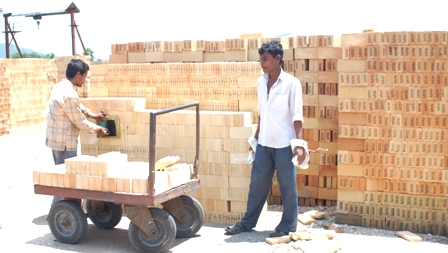Pores in Refractory Bricks (Porosity)
Porosity is the percentage relationship between the volume of the pore space and the total volume of the refractory sample. Apparent Porosity does not include the volume of the sealed pores. The True Porosity includes the volume of the sealed pores also. The usual difference between the apparent porosity and the true porosity is of the order of 1 to 2 percent unless the proportion of the sealed pores is high. The true porosity figure is the higher than the apparent porosity figure as the true porosity includes the volume of the sealed or closed pores also. The difference between the two values represents the percent volume of closed pores. Porosity can be controlled by the following:
=> By controlling the texture of the brick i.e. by controlling the size distribution of the particles.
=> By the methods of green manufacturing and composition.
=> By controlling the firing temperature, soaking time etc.
=> Quality of raw materials i.e. the inherent grain porosity of the raw materials used.
Higher the porosity, lower will be the strength of the brick. Bricks with lower porosity will have greater resistance to slag attack and more sensitiveness to fluctuations in temperature. Their thermal conductivity will be more.
Suggested Article: Bulk Density of Refractory Samples
Hence, apparent porosity is the percentage ratio of the void space in the refractory specimen to the total bulk volume of the same. There are two methods used for the determination of apparent porosity of refractory materials which are:
=> Boiling point method, and
=> Evacuation method.
Refractory Samples (Refractory Specimen) measuring 6.5 cm x 6.5 cm x 4 cm is cut from burnt refractory bricks by a cut off wheel from within its core and cleaned any dust or loose particles adhering to its surface and are dried in an oven at 110OC to a constant weight. For graded materials take 3 to 5 mm size grains and dry at 110OC. It can be determined by following the steps given in any of the Standard Methods for Refractory Testing like - ASTM, Indian Standards (IS), Ghost, DIN etc.
True Porosity (%) = {1 - (Apparent Sp. Gr. ÷ True Sp. Gr.)} x 100
Apparent Porosity (%) = {(Soaked Wt - Dry Wt) ÷ (Soaked Wt - Suspended Wt)} x 100
Related Articles
- How to manipulate test results of Apparent Porosity (AP) during Testing of Refractory Bricks (Refractory Inspection)
- Permeability of Refractory Bricks and Monolithics
- How to check Alkali Resistance (AR) of Refractory Lining - Bricks and Castables









